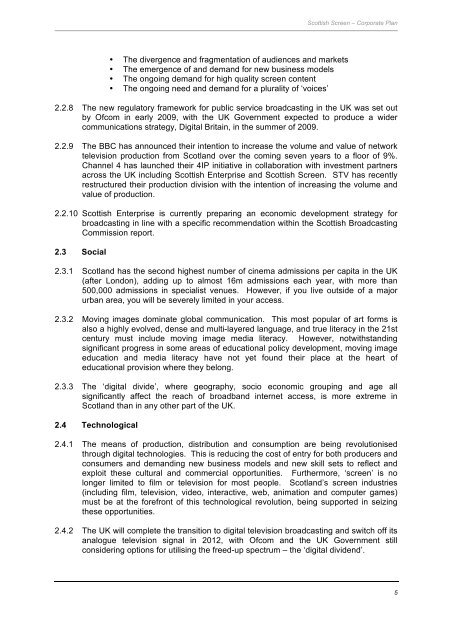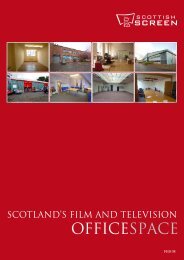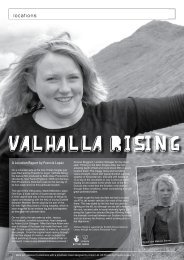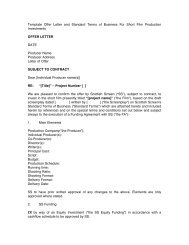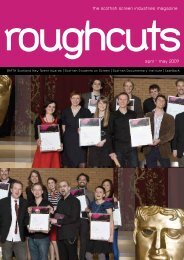Scottish Screen Corporate Plan
Scottish Screen Corporate Plan
Scottish Screen Corporate Plan
You also want an ePaper? Increase the reach of your titles
YUMPU automatically turns print PDFs into web optimized ePapers that Google loves.
<strong>Scottish</strong> <strong>Screen</strong> – <strong>Corporate</strong> <strong>Plan</strong><br />
• The divergence and fragmentation of audiences and markets<br />
• The emergence of and demand for new business models<br />
• The ongoing demand for high quality screen content<br />
• The ongoing need and demand for a plurality of ‘voices’<br />
2.2.8 The new regulatory framework for public service broadcasting in the UK was set out<br />
by Ofcom in early 2009, with the UK Government expected to produce a wider<br />
communications strategy, Digital Britain, in the summer of 2009.<br />
2.2.9 The BBC has announced their intention to increase the volume and value of network<br />
television production from Scotland over the coming seven years to a floor of 9%.<br />
Channel 4 has launched their 4IP initiative in collaboration with investment partners<br />
across the UK including <strong>Scottish</strong> Enterprise and <strong>Scottish</strong> <strong>Screen</strong>. STV has recently<br />
restructured their production division with the intention of increasing the volume and<br />
value of production.<br />
2.2.10 <strong>Scottish</strong> Enterprise is currently preparing an economic development strategy for<br />
broadcasting in line with a specific recommendation within the <strong>Scottish</strong> Broadcasting<br />
Commission report.<br />
2.3 Social<br />
2.3.1 Scotland has the second highest number of cinema admissions per capita in the UK<br />
(after London), adding up to almost 16m admissions each year, with more than<br />
500,000 admissions in specialist venues. However, if you live outside of a major<br />
urban area, you will be severely limited in your access.<br />
2.3.2 Moving images dominate global communication. This most popular of art forms is<br />
also a highly evolved, dense and multi-layered language, and true literacy in the 21st<br />
century must include moving image media literacy. However, notwithstanding<br />
significant progress in some areas of educational policy development, moving image<br />
education and media literacy have not yet found their place at the heart of<br />
educational provision where they belong.<br />
2.3.3 The ‘digital divide’, where geography, socio economic grouping and age all<br />
significantly affect the reach of broadband internet access, is more extreme in<br />
Scotland than in any other part of the UK.<br />
2.4 Technological<br />
2.4.1 The means of production, distribution and consumption are being revolutionised<br />
through digital technologies. This is reducing the cost of entry for both producers and<br />
consumers and demanding new business models and new skill sets to reflect and<br />
exploit these cultural and commercial opportunities. Furthermore, ‘screen’ is no<br />
longer limited to film or television for most people. Scotland’s screen industries<br />
(including film, television, video, interactive, web, animation and computer games)<br />
must be at the forefront of this technological revolution, being supported in seizing<br />
these opportunities.<br />
2.4.2 The UK will complete the transition to digital television broadcasting and switch off its<br />
analogue television signal in 2012, with Ofcom and the UK Government still<br />
considering options for utilising the freed-up spectrum – the ‘digital dividend’.<br />
5


